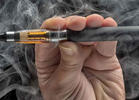
On October 4, Oregon Governor Kate Brown issued an executive order directing the Oregon Health Authority (OHA) and the Oregon Liquor Control Commission (OLCC) to “enact a temporary ban on the sale of flavored vaping products, as well as other sources or additives as they are identified in cases of vaping-related lung injury or death.”
OLCC makes rules for the marijuana industry while OHA, as the state’s public health agency, oversees nicotine and CBD vaporizers.
Last week, OHA recommended to the governor that the state impose a six-month ban on all vape products. That agency has not yet announced when it will start its rule-making process for this temporary flavor ban.
Other states that have banned flavored vape products include Michigan, Montana, New York and Washington. In Massachusetts, sales of all oil-based vape products were placed on hold for four months, starting September 25.
On October 11, the OLCC announced the ban would begin on October 15. According to OLCC spokesperson Mark Pettinger, cannabis-derived terpenes are not included in their definition of “flavor,” so those oil products will not be included in the ban. Only those products that use natural or artificial flavorings will be banned.
Retail establishments that continue to sell cannabis carts "flavored with chemicals that aren’t extracted from marijuana" will face fines and possible revocation of licenses.
Some weed shops in southern Oregon had reportedly been taking flavored vape oils off their shelves prior to this executive order.
According to Oregon’s state health officer Dr. Dean Sidelinger, the two vape-related deaths in Oregon have involved products purchased legally at licensed marijuana stores.
During a tour of local shops on McLoughlin Blvd. in Portland, the Green Stop dispensary still had a few flavored products on the shelves along with a copy of a statement by an oil manufacturer about their contents. The store stopped ordering flavored vape oil not long ago and may run out of stock before the ban hits.
The vape shop next door, Luxury Vapors, on the other hand, was filled with flavored vape oils. The same went for another store a block further down, Tony’s Smoke Shop. At the corner convenience store, Plaid Pantry, the vape section was still stocked with flavored products. Surprisingly, none of them were offering discounts to try and clear inventory. Perhaps they think they can just wait out a temporary ban, but that might not be a wise strategy.
The governor’s order also directs OLCC and the OHA to develop legislative proposals to:
• Ban all flavored vaping products permanently, including those containing nicotine or THC;
• Disclose all ingredients in vaping products to consumers;
• Increase the regulatory oversight of vaping products; and
• Clarify and expand OHA’s authority to take action when a harm or risk to the public’s health is present.
Cases in Oregon have involved people who vaped only nicotine products as well as people who knowingly vaped only cannabis. While some appear to involve illegally produced and purchased vape products, according to Oregon’s state health officer Dr. Dean Sidelinger, the two vape-related deaths in Oregon have involved products purchased legally at licensed marijuana stores.
Twenty-nine people nationwide have died from vape-associated lung illnesses since late August. The Center for Disease Control and Prevention still doesn’t know what is causing these illnesses and deaths. Possible causes range from additives and diluents to toxic chemical fumes to hydrogen cyanide.
“People should stop vaping immediately,” he stated. “If you vape, whether it’s cannabis, nicotine or other products, please quit. These are addictive substances, and we encourage people to take advantage of free resources to help them quit. If you haven’t started vaping, don’t start.
“What we’ve seen in this epidemic is that we have individuals who are very naive to vaping, who only started vaping for a short time and can have this illness, and we do not know the full, long-term impacts of vaping. No amount of vaping, even an occasional vapor, is safe.”
This article was originally posted on October 8. It was updated on October 11.







